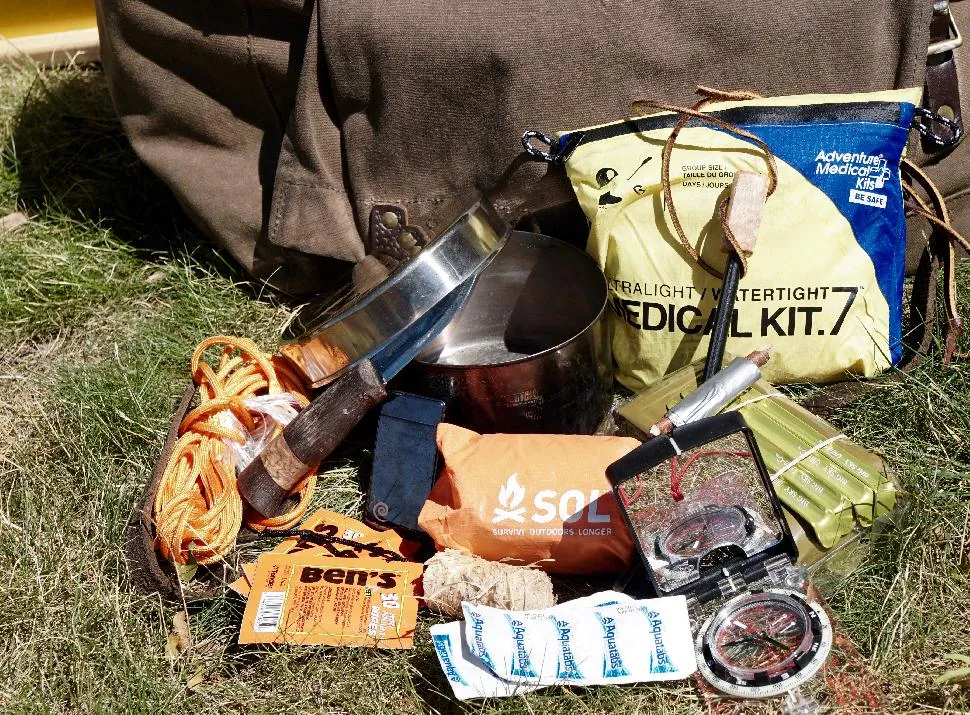The Happy Camper: Survival Kit Know-How

I had made an elaborate survival kit for my solo canoe-trip on northern Ontario’s remote Missinaibi River. Problem was, I left it in the boat when I ran into the thick boreal forest while trying to snap a picture of a wolf I had just seen along the shoreline. A few minutes later, I was standing amongst a bunch of black spruce, all of which were the same size and shape. I was disoriented, confused of my whereabouts, on the verge of panic and lacking a good wolf photo. If it wasn’t for a navigational trick I remembered from some old episode of The Forest Rangers, I wouldn’t have been able to use the sun to direct myself back to my canoe.
Survival kits are important to pack along, so long as you have them with you at all times. Lesson learned. And for even more humility, the wolf was standing on the opposite bank when I returned.
There are various types of survival kits—one you store in your car, one you stuff in a pack for a day-hike and one you carry while running rapids on a wild river. However, any emergency kit for wilderness travel must have the bare essentials for a short and miserable time in the woods. It has to be minimal, but provide you with means to start a fire, boil water, make shelter, navigate, signal for help, perform basic first-aid, catch a fish or trap an animal and fix gear. Essentially, you want the kit to protect you from the elements and assist you in being rescued.
To keep size and weight to a minimum, which allows you to keep the kit on you at all times, follow the survivalist code of the “rule of threes.” In three hours you can die of exposure; in three days you can die of thirst; in three weeks you can die of hunger.
Here are my essential survival items, which I store in a waterproof metal container (the container itself can be used as a cup or cooking pot). Some items can be eliminated to cut down weight and bulk, depending on how you’re travelling. Just keep the “rule of threes” in mind when doing so.
Survival Kit List:
- Heat-reflective blanket. I upgrade to a small survival bivvy during the shoulder season. SOL (surviveoutdoorslonger.com) offers a wide range of survival blankets and bivvys. Heat from a survival candle may also help.
- Paracord. I purchased a product called Fish ‘n Fire Cord. It’s seven-strand 550 paracord with eight-pound-test fishing line and jute-twine blended inside the cordage. The fishing line can be used for catching fish and the twine can be used as a fire starter.
- Rain poncho or industrial-sized garbage bag. You’ll need more than just a bunch of branches and leaves to keep your shelter dry.
- Fire-starting kit, including a lighter or waterproof matches and/or fire steel and fire starters. You can purchase fire starters or make your own out of cotton swabs soaked in Vaseline, or dryer lint mixed with lip balm.
- A knife. Of course, you should already have a knife (and fire steel) attached to your belt or hanging around your neck.
- A compass—and knowledge of how to use it.
- Water purification tablets. These tablets—like Aquatabs—are effective and smaller to pack than a water filter. (I’d also consider a LifeStraw water purification system.)
- Aluminum foil. You can form a pot, cup or bowl. I’ve even used a piece of foil as a makeshift fishing lure then baked the fish in the remaining foil.
- Emergency locator beacon, such as those from SPOT or InReach. There’s no reason why you shouldn’t consider at least renting one of these devices if you’re going to be travelling in a remote wilderness area. And make sure to pack extra batteries.
- Whistle. Remember: three strong blasts is a distress signal.
- Fishing line—even dental floss works. And a few fishing flies. They’re better than just packing plain hooks. A fishing fly is also a great way to catch a frog. Place the fly over the frog’s head and it’ll snatch it for sure.
- Mini-flashlight and batteries.
- A small pencil (for leaving notes) with snare wire and duct-tape wrapped around it.
- Small first-aid kit—and take a first-aid course every few years. It’s better to be equipped with knowledge than a bunch of gear you don’t know how to use.
- Bug repellent. Seems overkill to some—but they haven’t slept overnight in the woods waiting to be rescued sans bug dope. I pack both Ben’s Deet wipes and Ben’s UltraNet Head Net. The head-net compresses to the size of my big toe.















